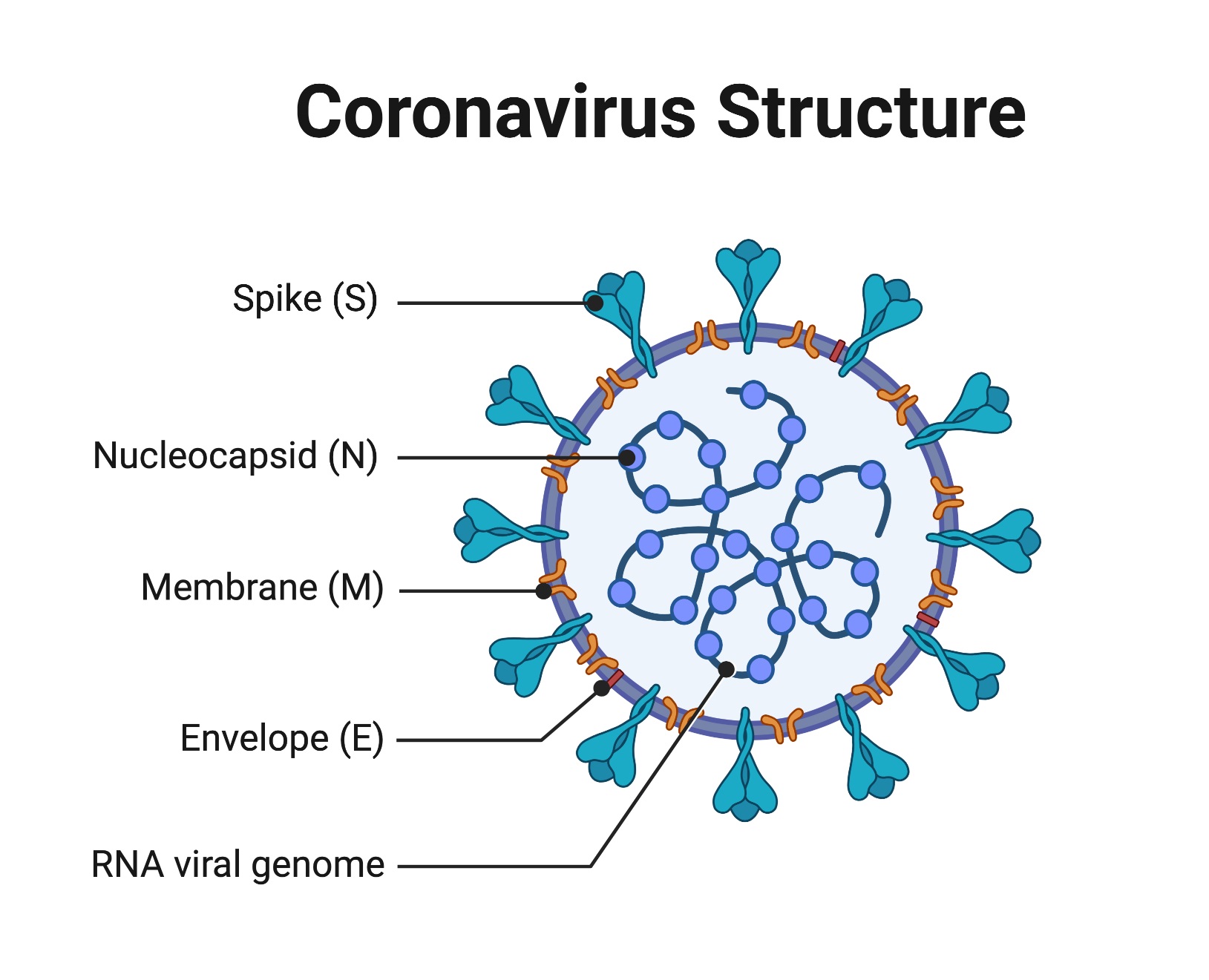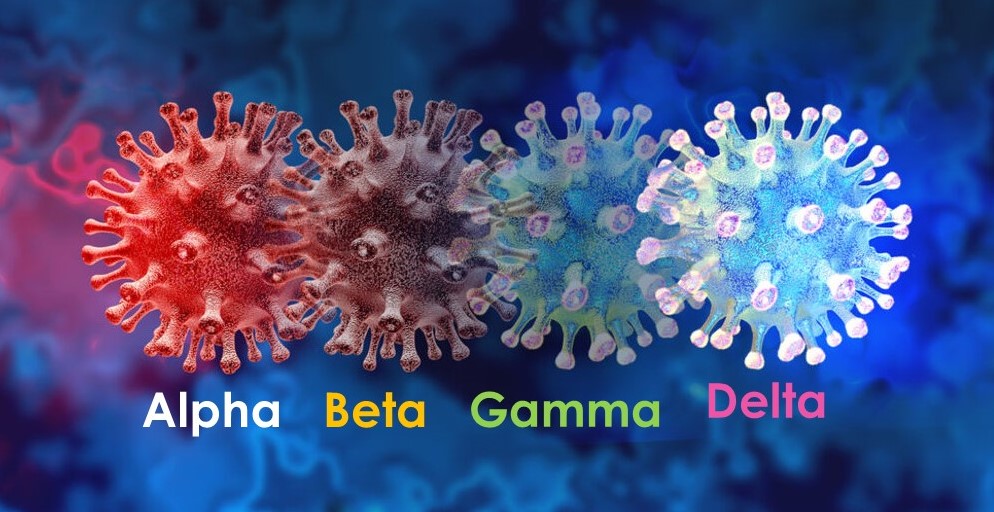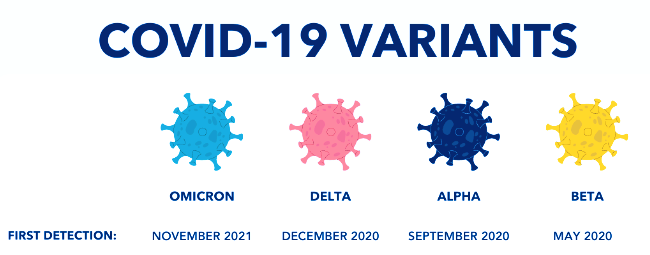
All viruses are made up of a bundle of genetic material (either DNA or RNA) that is covered by a protective coating of proteins, known as envelope. The projections seen on the outside of virus are spike proteins.

Coronaviruses are a highly diverse family of RNA viruses. A coronavirus identified in 2019, SARS-CoV-2, has caused a pandemic of respiratory illness, called COVID-19. Viruses that contain RNA as their genetic material mutate constantly. Like all viruses, coronaviruses are unable to thrive and reproduce outside of a living host.
Once the virus enters into your body through mouth or nose, it attaches to your cells. The virus’s RNA enters your cell and hijacks it. It then takes command and makes copies of RNA, which helps them spread.

If there is a copying mistake, the RNA gets changed. This change is called mutation. Mutant forms of viruses are called variants. In some cases, the variants are genetically distinguishable but not different; their mutations have no effect on their biology. In other cases, the variants are genetically distinguishable and different in their biology. Those variants are called strains. This a subtle distinction, but an important one. But, in the media, the words strain and variant are often used interchangeably.

WHO listed four “variants of concern”:
- Alpha
- Beta
- Gamma
- Delta
Since May, 2021. the World Health Organization (WHO) has started naming variants of the coronavirus after letters of the Greek alphabet, to simplify the variants’ names and avoid names that can be stigmatizing to a country.
 B.1.1.7 (Alpha): This variant was initially detected in the United Kingdom.
B.1.1.7 (Alpha): This variant was initially detected in the United Kingdom.- B.1.351 (Beta): This variant was initially detected in South Africa in December 2020.
- P.1 (Gamma): This variant was first identified in travelers from Brazil, who were tested during routine screening at an airport in Japan, in early January, 2021.
- B.1.617.2 (Delta): This variant was first identified in India in December 2020.
These variants seem to spread more easily and quickly than other variants, which may lead to more cases of COVID-19. An increase in the number of cases will put more strain on healthcare resources, lead to more hospitalizations, and potentially more deaths.
A slightly altered version of the Delta COVID-19 variant, Delta Plus, had spread through the US, UK, and India. Delta Plus has an extra mutation called K417N, which distinguishes it from the regular Delta variant. Scientists have some concerns about three worrying characteristics of Delta Plus variant:
- Faster spreading
- Stronger binding to lung cells
- Reduction in monoclonal antibody response
So far, studies suggest that the current authorized vaccines work on the circulating variants. According to new data, only 10% of the world’s population is fully vaccinated against COVID-19. Virus is spreading faster than vaccine rollout.

The Pandemic is not over yet. At this time, vaccination has proven to be our most effective tool. As long as the coronavirus continues to circulate, we will continue to see new variants emerge. The transmission of virus can be slowed, if more and more people have some immunity. That is why it is very important to get vaccinated when it is your turn!
Take home message:
- Stay healthy and keep your immune system in shape
- Continue practicing hand washing, using mask and social distancing
- Get vaccinated as early as possible
*The above information is from June, 2021.
Update on November 28th, 2021: On November 26, 2021, the World Health Organization (WHO) classified a new variant, B.1.1.529, as a Variant of Concern and has named it Omicron. The first case was found in South Africa. OMICRON is the 15th Greek alphabet. The last variant was Mu. Many people had expected the agency to label the latest variant nu, which comes after mu. WHO skipped Nu to avoid confusion with the word “new” and skipped Xi because of the similarity to the name of Chinese leader Xi Jinping.
Update on December 14th, 2023: Ever since it first emerged in 2019, COVID-19 virus has been mutating and creating new variants. The current variant is Omicron, which has been around since 2021. This variant, too, making new versions of themselves, called subvariants. So far, we have been seeing BA.2.86 (also known as Pirola), BA.4, BA.5 and they are causing upper respiratory symptoms including:
- Sore throat
- Runny nose
- Persistent cough
- Headache
- Fatigue
Scientists first identified the BA.2.86 variant in August 2023. Now, JN.1 was first detected in September 2023 in the United States and has been detected in 11 other countries. With this limited information, it is too early to tell whether it will spread more widely.

While new variants like BA.2.86 and JN.1 attract attention, right now, 99 percent of SARS-CoV-2 variants are part of the XBB group of the Omicron variant, which is what this year’s updated vaccines are based on. Regardless of the variant, all SARS-CoV-2 viruses spread the same way. So it’s important to protect yourself and others by staying up to date with COVID-19 vaccines, improving ventilation and staying home when you’re sick.

 B.1.1.7 (Alpha): This variant was initially detected in the United Kingdom.
B.1.1.7 (Alpha): This variant was initially detected in the United Kingdom.
Great article on mutation and variant. one by one articles are coming. congratulations savi.
Thank you.
covid 19 variants article gave very detail introduction…. congratulations savi…grt….we r waiting for new informative article….best of luck…savi
Thank you.
👌info on 🦠
Thank you.
Nice Article
Thank you.
Awesome article. Very informative and concurrent topic of interest.
Thank you.
Fine article 👌👌
Thank you.
So simplified article Savitra..you are an amazing person.👍👍
Thank you, dear!
Very informative. Very good graphics grabs attention. Now I know the difference between strain and variant.
Thumbs up.
Thank you 🙂
Nice article 👍👍
Thank you.